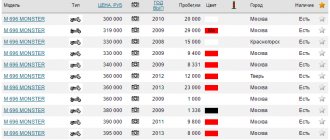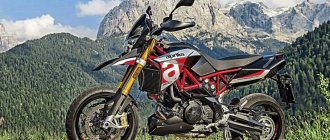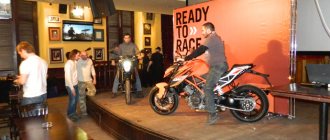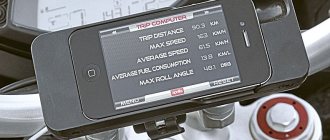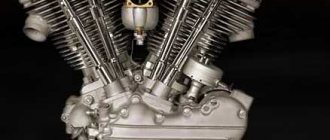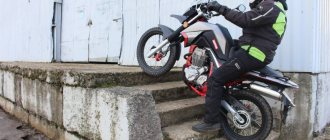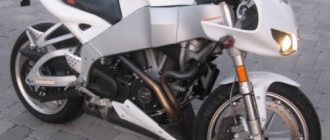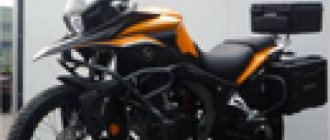The Aprilia Shiver 750 motorcycle gained popularity because it was uncomplicated, not very demanding and yet it had character and was a lot of fun to ride. Did Shiver 900 follow in his footsteps?
Motorcycle Aprilia Shiver 900
Shiver, that is, “shiver”, has always been a little like Monster or Fazer: the goal was to attract bikers and keep them engaged with the brand longer, representing the entry level for those who want to be more original. The first Shiver in the 750 version brutally killed the Euro 4 standard. And now Shiver is back with a new version, 900 cm3. The larger engine is, of course, stronger (although only by 3 hp) and has higher torque (about 8 Nm), but this is not the main thing. More important is the soft, smooth and predictable throttle response, which was not the first Shiver's strong suit. On the contrary, the tests showed a harsh, but rather nervous reaction to the gas.
The tidy is OK, especially the welcome screen with the Shiver 900 logo.
The V2 engine, which is also installed in the Dorsoduro 900, is 11 mm longer than the first stroke of the Shiver and therefore increases the displacement. What also caused this change is that maximum torque only appears at 6500 rpm, rather than previously at 4500. The new engine has the advantage that the high torque is available almost across the entire scale, and you don't really feel any overt torque. its drops or increases until the cutoff, i.e. approximately 10,000 rpm. The motorcycle, from start to finish, pulls smoothly and dynamically. The use of new solutions in the gas distribution system has led to the fact that an additional oil cooler in the engine has become unnecessary.
slight chills
Shiver is not a giant. Its engine is built into a fairly compact steel and aluminum trellis frame, making for a visually interesting design. The riding position is typical of a naked bike or streetfighter - not too wide, not too narrow, a simple steering wheel, and a flat and wide 810mm seat that encourages easy forward gliding. Placed quite high, but not sporty at the rear, the pegs bend the knees. The only annoying thing is that the passenger kits are too close together. If you have a larger foot, then when moving in a more sporty style, your boot will rest on the passenger bracket.
Front hinge adjustment is only available on the right front fork. There is no adjustment on the left
Despite its small size, the motorcycle weighs 218 kg. That's a lot. Luckily, thanks to the excellent balance, you don't feel it while driving. And the trip is a very pleasant experience. After turning the key, the color TFT display panel greets me with the intro of “Shiver 900”, followed by a neat and clear “message board”. There is information about the electronics (ABS and three levels of traction control), a map of the selected driving mode and much other information. There is also an effective shift.
Modifications
The motorcycle has no official modifications, but 3 variants can be found on sale - 2021, 2021 and 2021. No tuning was carried out - all three versions have an identical appearance, the only slight difference is in the “filling”:
- The 2021 Shiver SL 900 is the first city bike to feature electronic throttle control.
- Shiver 900 2021 - in this version, fuel maps can be switched with the starter button directly while driving. Everything else is adjusted using the joystick on the left remote control.
- Shiver 900 ABS E4 2021 – updated Marelli 7SM ECU installed. This version also reduces piston friction thanks to a new casing design. The Aprilia Multimedia Platform has been added to the dashboard.
Big shock
I press the starter button and there is a loud, shuddering sound. “Oh, hence the name,” I thought. Now the clutch - the handle works neither hard nor easy. Oh, this requires a certain handshake. Even though it was raining during the test, I didn't hesitate for long - the Sport mode map and the least invasive level of traction control. The most responsive Level 3 intervenes unnecessarily early, and the response and power delivered in the Sport map is predictable and easy to understand. Maybe that's why I feel like this bike has had its claws filed down a bit.
Two-pipe. Two barrels with mufflers under the seat, with characteristic pipes, look strange, but their juicy bass sounds just right!
The Shiver handled the fast pace of dry riding with ease, but I must add that it seemed to lack a bit of madness. The Aprilia accelerates dynamically throughout the rev range and does so in a civilized manner: it doesn't vibrate excessively, doesn't make noise or tries to throw you out of the saddle. It keeps its shape all the time, and the decline is felt only at high speeds - only then do you feel that this is a “900”, and not a larger engine.
Also in corners, the Shiver is nothing to be ashamed of. The rear end can act up when exiting corners, especially under someone who, like me, weighs almost 100kg. On the other hand, the front end is a good combination of sporty stiffness and comfort, thanks to its unevenness, confident handling and without loss of resonance. And if something happens, you can adjust it. Convenience is at a high level, although I won’t say that Shiver is impulsive - you just need to know what you’re doing, then he’s obedient. It’s the same with the brakes – the calipers with the “Aprilia” inscription illusoryly resemble Brembo radials. They are effective, but require self-confidence - if you pet them, you will not be happy.
An unpleasant nuance: the rear pegs and their handles are located too close to the front ones. When you're riding at a sportier pace this feature is a bit of a concern
Test drive ApriliaShiver 750 GT, Ducati696 Monster
From the editor: The idea of bringing these two Italian naked bikes “face to face” originated with us when they had just appeared in Ukraine. But for various reasons, we were able to bring this idea to life only two years later.
It was interesting - two “hot” Italians, lively and handsome, somewhat similar to each other, but so different... And two journalists - both young, energetic, smart, experienced, but... also different! This means that their opinions about motorcycles must be different! Or is it the same?.. So we’ll check it! But the day before the test, organized with such difficulty, the sad news came: the Monster 696 for some reason does not want to start... Here I would like to write about a happy occasion and luck, but... In fact, we are very grateful for a similar motorcycle, provided at the last moment Dmitry and Ivan Nikolaevich Chebotar. Yes, yes, it was they who turned out to be the first lucky ones that, thanks to the “Giveaway Monsters!” campaign carried out by the KLO gas station network. won one of the three Ducati Monster 696. And it was raining all week before the scheduled test date, but the “heavenly office”, apparently following all our misadventures and clearly reading “MotoDrive”, still took pity on us and sent us a day of sunshine. Special thanks to her for this too! Well, now - let's go!.. Journalists, of course.
Vladislav Sofonov
The Monster family has been around for quite a long time (since 1993), and therefore, when creating its Shiver, Aprilia had the opportunity to analyze all the advantages and disadvantages of the competing model. At that time, it (the competitor) was also the Monster 695, which replaced the clearly outdated “620” in 2007. At its debut, the Shiver was indeed ahead of the Ducati Monster 695 in both design and performance. But just a year later, Ducati released a new Monster with the index “696” - sophisticated, elegant, aggressive and... sexy, as an Italian motorcycle should be. You can argue for a long time about which of the Italian “machos” is more beautiful, but you need to agree on one thing - they are different.
And the test confirmed it. Already in the first few meters behind the wheel of the Shiver you understand how it is weighed down by the considerable weight and “heavy” steering wheel. It’s heavy because when maneuvering at low speeds (up to 30 km/h), it tends to lean towards the turn, and you have to put in some effort to keep the motorcycle on the desired trajectory. If we add to this the fact that the Shiver’s steering turn is not very large, it becomes clear that driving at low speeds in traffic jams or traffic jams is clearly not its strong point. It’s good when you manage to slip them through the aisles - the width of the steering wheel allows this quite well. Shiver is a city “lighter”, and therefore it feels much better where there are not so many cars. In such conditions, he is quite capable of misbehaving, accelerating not only low-speed Zhiguli cars, but even “sporty” Lancers with a rich exhaust sound.
Its “veshka” unwinds almost instantly, providing a good pick-up starting from 4 thousand. The precise operation of the gearbox and the small foot stroke allow you to shift quickly and easily, maintaining an aggressive riding rhythm. The hydraulic clutch works well, but due to the lack of a clear connection and the very small stroke of the handle, it is difficult to detect the onset of the “contact patch”, and therefore, when moving away at low speeds, my motorcycle often stalled. Radial 4-piston brake calipers from Brembo delight with their strength and informativeness. And ABS instills confidence that on our sand-strewn roadsides there will be no sudden blocking of any of the wheels. Of course, compared to the systems found on top brands, this one works more harshly (during emergency braking at low speeds, it pushes the front brake handle too sharply and allows the front wheel to lock for a short time), but still the presence of ABS is a positive thing for our road conditions.
A couple of years ago I rode this motorcycle, and then it seemed almost motard to me. And the point is not only in its engine with torque available from the bottom, but also in the energy intensity of the suspension, which swallowed almost any irregularities. This time the opinion about the suspension has changed somewhat. Everything largely depends on the suspension settings, or more precisely, the rear monoshock absorber (the fork does not have them). If you loosen it up a little in terms of preload and rebound hydraulics, then the Shiver will really pass for a motard. But the settings (apparently standard ones) this time turned out to be stricter, and the motorcycle turned from a motard into... a typical streetfighter, although what’s surprising here?!
Monster 696 weighs almost 30 kg lighter than its opponent, it has a much lower center of gravity and smaller dimensions. When you sit on it after Shiver, it seems that under you there is a compact and unusually light motorcycle. It handles excellently, both at low and high speeds, and also takes corners easily. Only the landing on the Monster is not comfortable. Thanks to the low seat, the legs can easily reach the ground, but its padding and profile, and especially where it attaches to the tank, leave much to be desired - it presses... Guess where. Maybe in this way the Monster shows its “sexiness”?.. Also, because of the low steering wheel, you have to bend over a lot to reach the handles. In the city you pay little attention to this, but if you have to go far beyond its borders, then the upright and relaxed landing that the Shiver can boast will still be preferable. And mirrors! Not only do they look strange, dissonant with the foppish appearance of the “Monster,” but nothing is visible in them (except for their own shoulders).
Another difference that I felt during the first braking on the “Monster” was how sharply the front calipers “bite” into the discs even when lightly pressing the handle, causing a noticeable dive of the front suspension. The rear brake on this motorcycle rarely has to be used - in most cases, engine braking is enough, but it is immediately noticeable that its information content is noticeably higher than that of the Shiver. Thanks to the high power of the braking system and low weight, the Monster 696 is ahead of its competitor in braking, but due to the lack of ABS in our test unit, in order to give it all, the driver of the “Monster” needs to be able to balance on the verge of the wheels falling off, and this is a minus for active safety . It’s a pity that for a full comparison we didn’t get a Monster 696 model with pre-installed ABS, but there are some.
Regarding the Monster 696 pendants: their operation is similar to that of the Shiver. I didn’t feel a noticeable difference with standard settings, just a smaller stroke. They absorb small bumps well, but when driving over large ones, impacts are felt both on the steering wheel and on the seat. Perhaps for our roads, the rear shock absorbers of both motorcycles really should be loosened a little.
The operation of the Monster 696's hydraulic clutch is simply amazing - it is so soft that it may seem that the handle is working "idle". In addition to this, the motorcycle is equipped with a cam gearbox in which all gears are in constant mesh. That is, when switching, no time is wasted synchronizing the rotation speeds of the gears, which means there is no clanging characteristic of conventional gearboxes.
But a much more significant difference lies in the engine of the Monster 696. Based on the name of the motorcycle, it should be angry and aggressive. But in fact, it is balanced enough not to scare even a beginner. It is not for nothing that Ducati considers this motorcycle an entry-level motorcycle, and it is on it that the Ducati Riding School (at least here, in Italy) begins to teach driving to those who get behind the wheel of a motorcycle for the first time. At the “lower levels” it is not capable of scaring anyone - the power increases very smoothly. In addition, the air desmodromic with two valves per cylinder does not spin up as quickly as the Aprilia engine with 4-valve heads and the proprietary Ride-by-wire electronic system, which controls the opening of the throttles for maximum engine output at all speeds.
If you compare the power and torque curves of both motorcycles, you will immediately notice a significant gap between the Monster 696 and its competitor. The Ducati has a slight dip in mid-range revs, so to ride it aggressively you have to keep the revs above mid-range at all times. Shiver does not have this drawback - it has good both medium and high speeds, and the cutoff is triggered later.
The different styles and characters of these motorcycles undoubtedly leave an imprint on the portrait of their future owners. These portraits will vary. For those who prefer to drive aggressively, leave traffic lights on the rear wheel and scare everyone with a rich exhaust sound, the Monster 696 is clearly contraindicated. It has some aggression, but still, it has much more sophisticated Italian style. This is a motorcycle for those who love sophistication, uniqueness and prefer to have things that others don't have. The second “Italian” is sharper, more dynamic, and what is also important is that it reacts more easily to the unevenness of our “directions”. Do not forget about physiology: the determining factor in the choice may be the anthropometric parameters of the owner - taller and larger ones will prefer the tall Shiver with its straight fit, and those who prefer a more sporty inclined fit and do not have long legs may turn their attention to Monster.
Sergey Kuznetsov
When I was offered to come to Kyiv to test the Aprilia Shiver 750 and “Well, maybe the Ducati Monster 696,” I thought for quite a long time... about a second and a half. That is, exactly as much time as it takes to get more air into your lungs for a loud and expressive statement of your consent.
Tricky thoughts began to appear approximately halfway between Kharkov and Kiev... Somehow I accidentally remembered the winter test of an ATV from Aeon, when instead of the promised 350 cc sports quad, the entire team of fairly well-fed testers was seated on the baby Overland 180. After all, you must agree: cake is a good thing , but when there was a cake in the future... It somehow turned out faded. I hope the analogy is clear. These are roughly the thoughts that swarmed in my head until the moment I saw Shiver. And when I saw it, I realized that I wouldn’t be left without a hefty piece of cake.
The appearance of the motorcycle is the quintessence of the thoughts of the best Italian designers, who are now carried away by the “transformer” style in the battle for the sympathy of buyers. Beautiful? Yes! Effective? Undoubtedly! You look at the face - it’s amazing! You look at the butt - babble! And the motorcycle on the side – oh, how good it is. Although, some conservatives may find the design of the motorcycle too shocking. However, instead of reading my opinion, you can look at the photo and form your own. Well, did you take a look? Made up? Then let's continue.
Walking around the motorcycle revealed a number of interesting points. I was particularly pleased with the presence of ABS, because for a motorcycle that is used most of the time in the city, this is a very useful “bell.” But what was disappointing was the lack of adjustments for the front suspension, and more than modest adjustments for the rear. The equipment doesn’t seem to be cheap – they could have added “twisters”. However, I decided not to make hasty conclusions. Next I became interested in the dashboard and its controls. Instead of the usual buttons near the display, a three-position joystick is placed on the left remote control, so you can play with settings and navigate the extensive menu even while driving... Theoretically, of course! The list of displayed information is such that both “sports” and even some “tourists” will envy it. Here you have instantaneous fuel consumption, a lap timer (a sports chronometer for measuring lap times), and a customizable blinker.
I sit down. The seating position is high, the steering wheel is wide, the back is straight... strange, it seems that I didn’t come to test an enduro, but all the tactile sensations indicate the opposite. Have you been deceived again?! However, after fidgeting on the obviously “non-enduric” seat and touching the clearly “non-enduric” tank, I calmed down somewhat and began to carry out a series of procedures to bring Shiver into combat readiness. Finally, the tachometer needle came to life and, accompanied by the cheerful blinking of the indicators, darted across the entire scale in test mode. A second later, the starting roar of the engine turned into a menacing rumbling. The exhaust sound at idle is specific and slightly reminiscent of the operation of a large monocylinder.
From the first meters of movement, the motorcycle gives the impression of a compressed spring, which is ready to straighten out and shoot forward, carrying the pilot along with it.
The clutch engagement moment with a hydraulic drive is quite sharp, and everything would be fine, but... the engine does not want to pull confidently and accurately respond to the position of the throttle until the 3000 rpm mark has been passed. For a 750cc fuel-injected V-twin whose throttle valves are also electronically controlled, this is a strange feature. It could only be that in sunny Italy they once again gave in to environmentalists - I have no other explanation for this yet. Therefore, for a confident start, you have to turn up about 3-4 thousand revolutions (fortunately, the engine reaches them instantly), and rush headlong to the next traffic light under the roar of the awakened engine. However, my attitude could have been influenced by the test of the energetic KTM 990 Duke that took place the day before - the “Austrian” tried to get away from the rider almost immediately after launch.
Once I stalled while driving, I shared my doubts with a colleague.
“No, I didn’t notice,” he answered phlegmatically.
Well, yes, of course... And it stalled when starting, probably also out of love for the process of starting the motorcycle?
However, in all other modes the engine worked great, justifying the epithet of a compressed spring. As soon as the dip at low speeds ended, smooth and powerful acceleration began, which extremely relieved the front wheel, forcing it to only lightly touch the asphalt.
If you stick into 5th or 6th gear at a deliberately low speed and sharply open the gas, you can feel the presence of the ride-by-wire system (electronic throttle control), which consists of the absence of a direct mechanical connection. It prevents the engine from “choking” and “convulsing” after the barbaric antics of testers trying to check such an indicator as elasticity. Now answer the question: what unites a motorcycle and a mobile phone in vibration alert mode? Well, yes, that’s right - it’s vibrations that unite them. Only in the second case are body vibrations designed to attract attention, preventing them from being ignored. And in the first - to be invisible, but useful, directly informing the pilot of the approximate crankshaft speed. Shiver is the very first case. You can take this as a compliment.
As I clocked up the kilometers around the city, I began to gain respect for the Aprilia designers. After all, creating a good engine, or a great chassis, or a powerful braking system, or drawing a cool design is not so difficult. But bringing it all together, and also keeping the price at an acceptable level, is quite a task. Some stories shock with a list of individual features:
– 200 horsepower!
- Wow!
– Monoblock radial Brembo!
- Wow!
– Multi-adjustable Ohlins!
- Fantastic!
Shiver is not like that. It impresses with its balance and harmonious work of all components. When cornering, the motorcycle is clear and predictable; you don’t have to fight with it for the right to have the “final say” in choosing the trajectory. Need to go left? Let's go left! Need to go right? No question, go right! Do you want to go straight? Ok, right in the center! Complete freedom of action and no restrictions from the bike.
The brakes added an extra dose of respect. As a rule, in this case it is customary to talk about how you, so fast and beautiful, encountered some unexpected obstacle on your way in the form of a pillar crossing the road. And about how you heroically avoided a collision by using... well, at this point an ode to the brakes is inserted. But no. There was nothing like that. But the brakes really deserve praise. Not only are these four-piston Brembos with two 320 mm discs, but they are also equipped with an anti-lock braking system, the main part of which is located in the “plow” in front of the engine. ABS, for my taste, is set up flawlessly, although it works a little rough. That is, it allows the pilot to press the brakes almost to the last minute, intervening only a moment before the wheels lock. In addition, the system has one more “feature”: at “near-pedestrian” speed the ABS is turned off, so you can drive the last couple of meters to the traffic light in a nice “stoppie”.
Shiver allows the rider to feel like a fish in water in the city. The high, straight seating position is not tiring and allows you to view traffic over the roofs of cars. Easy handling, large steering angle and a “cheerful” engine make it possible to respond appropriately to any change in the environment. The suspensions do a good job of filtering out almost all road surface defects, allowing only the most obvious potholes to reach the driver’s backside. By the way, about pendants. In front there is a non-adjustable “shifter” with a feather diameter of 43 mm. At the rear there is a monoshock absorber with adjustable preload and rebound damping. If you don’t pick on little things that are difficult to identify during city use, I would call the calibrations ideal, and the entire chassis as a whole very successful.
Honestly, I didn’t expect that with such a set of positive qualities, Shiver would have normal mirrors. But... a fact is a fact: in bizarrely shaped cases there are quite good “rear view cameras”, in which at times you can see a lot of useful things.
Soon, having ridden, our brethren sat in the shade on a bench, waiting for the Ducati Monster 696 to arrive for testing. In Europe, it has already been dubbed “the most popular and iconic bike.” Cult - because Monster. Massive - because “696”. It is a descendant of the 695 model, differing favorably from its ancestor in design, modernized engine, more compact chassis, and more powerful brakes.
My thoughts about “monsterology” were interrupted by the deep rumble of a helicopter flying at an extremely low altitude. Following the sound, Ducati himself emerged from around the corner like a flash of red lightning, bringing a murmur into our not very orderly ranks.
It must be admitted that the designers “drew” a motorcycle that combines both classic and modern. Let's take a headlight for example. If you look at it from a distance, it’s just an ordinary round thing. You get closer, and it turns out there is a complex system of two reflectors separated by a horizontal molding. In fact, the Monster represents a motorcycle in its purest form and can act as a piece of art - there is nothing superfluous about it. It has just what you need for a dynamic ride. Perhaps it is for this reason that liquid cooling was sacrificed for less weight.
The L-twin of the new “Monster” is a traditional two-valve air vent with a desmodromic valve drive. Now I’m already reaching out with my finger to the starter button to start the engine, hot and ready for battle, when my eye stumbles upon the choke lever... Considering that the engine is equipped with a Magneti Marelli fuel injection system, this technical solution looks strange and... very original. Or is this also a tribute to the image of a “real motorcycle”, like air cooling? After this, the eye catches on the fully digital dashboard (or is it already an on-board computer?), which can do almost everything... well, except perhaps predict the future. Like the Aprilia, the Ducati also has a lap timer, which probably means periodic forays into track days. The functions of the device are controlled in the same way - using a button on the left remote control.
Got wound up. A quiet but clearly hungry roar of a long-unfed predator poured out of two massive mufflers.
The landing here is peculiar. You get the feeling that you are sitting not “on”, but “in” the motorcycle, while hanging over the handlebars. I believe this is done for a more complete and comprehensive contact with the bike. But, looking ahead, I will say that such a tight “unity” ultimately tires the rider.
The wheelbase of Shiver and Monster is almost the same (we don’t take into account the dramatic difference of 3 mm), but the second one does not have a “180th” rear balloon, but a narrower, “160th” one and less weight. Because of this, the Ducati exhibits even lighter handling than the Aprilia. Ideologically, it was created not for functional daily trips, but for dashes between traffic lights and short runs from cafe to cafe with a pretty, progressive passenger who is ready to take off her T-shirt at the right moment. To do this, under the bright plastic cover, which is immediately behind the driver’s seat, there is a “perch” for the “second number”, about the size and comfort of which you can not delude yourself.
The engine, or rather its character, is radically different from the Aprilia “vehicle”. Thanks to two-valve heads, the engine demonstrates excellent traction at low and medium speeds, as well as its precise dosing. More accurate than Aprilia. But at the “tops” the 696 cc air vent noticeably “blows away the cheeks”. What can you do here? Design specifics! Although the Ducati engine is inferior to its competitor in terms of peak horsepower and Newtonometers, its potential is more than enough to provide decent doses of adrenaline.
There is more sportiness in this motorcycle than in other sports bikes. Judge for yourself: a combined frame consisting of a tubular front section and a cast subframe, a torsionally rigid cast rear swingarm, an inverted fork with a 43 mm stay diameter, radial four-piston Brembo brake calipers. Yes, in all of the above there is a clear similarity with Shiver, but it all works differently. More expressive, right?
The Ducati braking system, although not equipped with ABS, works more informatively, and its initial “bite” is stronger than that of the Aprilia. As it turns out, not everyone likes such harshness. For example, I perceived it positively, but my colleague gave a destructive “fe!” In some ways, of course, he is right. If Shiver will be pleasant and understandable to everyone, from beginner to pro, then Monster will not appeal to everyone... Oh, not so! On the contrary: not everyone will like the “Monster” himself!
What didn't I like? Mirrors. No matter how you set it, you can only see the asphalt under the motorcycle. What pleasantly surprised you? You will laugh, but this is clutch. I have never seen such a “soft” lever on any bike! The moment of its “grabbing” is quite short and early, which once again emphasizes the sportiness of the bike.
But in terms of ease of use of the gearbox, Ducati slightly loses ground to its competitor. The gearbox is a little noisier, and you have to put more effort into it, but the switching speed itself is higher. To be fair, I note that I did not notice any “troubles” such as overshoots and “false neutrals” during the test. The gear ratios are chosen very well and fully realize 78 hp. and 68 Nm, built into the engine by the designers. Once again, breaking away from a traffic light on the “Monster”, I realized what exactly I would like to change in the Aprilia... Shorten the first gear - that’s what! Someone will say that a long “first” is a blessing and they will be right in their own way - you can drive in a wide range of speeds without clicking your left paw once again. But for some, the sight of the front wheel rolling on the ground during acceleration will seem unbearable - this is where a shorter first gear would come in handy.
Carried away by the ride, we noticed with some delay that the test day had come to an end. Well, we’ll have to part with the company of temperamental “Italians” and take stock.
Aprilia SL 750 Shiver and Ducati Monster 696 cannot be called direct competitors. Rather, they come from neighboring clans. The first is a respectable roadster with a dash of streetfighter blood. The second is a cafe racer in a modern interpretation. Therefore, the presence of one of them in your garage will not at all interfere with the purchase of another. For the “company”, so to speak. In their apparent unity they are still very different.
Text: Vladislav Sofonov
Sergey Kuznetsov
Photo: Andrey Shlenchak
Total profit
When you come out of a corner, the sound of the strange-looking dual muffler makes the hair on your head stand up. This makes you forget about the shortcomings that previously bothered you: significant fuel consumption (6.2 l / 100 km), the harm of Italian electronics or the slight turn of the steering wheel.
It is worth mentioning the fact that Shiver 900 costs 660,000 Russian rubles. That's less than you'd pay for a Yamaha MT-09, Kawasaki Z 900 or Ducati Monster 821. In this class, only the Suzuki GSX-S 750 is cheaper, while the Triumph Street Triple costs the same. This is just a tough nut to crack!
Aprilia Shiver 900
You select traction control modes from the starter level. There are three maps: Rain (power limited to 70 hp), Tour (soft gas response) and Sport (fire!)
Post Views: 3,510
Specifications
Engine
| Number of cycles | 4 |
| Number of cylinders | 2 |
| Number of valves per cylinder | 4 |
| Motor Configuration | V-shaped |
| Working volume | 896 cm³ |
| Bore and stroke | 92×67.4 mm |
| Maximum power | 95.2 hp at 8750 rpm |
| Maximum torque | 90 N•m at 6500 rpm |
| Intake system | Injector |
| Recommended fuel | Petrol |
| Cooling system | Liquid |
| Starting system | Electric starter |
Transmission
| Transmission | Mechanical |
| Number of gears | 6 |
| Clutch | Multi-disc, oil bath |
| main gear | Chain |
Chassis
| Front suspension | Inverted telescopic fork |
| Front suspension travel | 120 mm |
| Rear suspension | Pendulum with monoshock absorber |
| Rear suspension travel | 130 mm |
| Front tire | 120/70 ZR17 |
| Rear tire | 180/55 ZR17 |
| Front disc | 3,5×17 |
| Rear disc | 6×17 |
Brake system
| Front brakes | Double disc hydraulic with radial 4-piston calipers |
| Front brake disc diameter | 320 mm |
| Rear brakes | Hydraulic disc with 1-piston caliper |
| Rear brake disc (drum) diameter | 240 mm |
| ABS | ✓ |
Other data
| Fuel tank capacity | 15 l |
| Frame | Modular, steel, aluminum |
| Manufacturer | Aprilia |
| Country of Origin | Italy |
Engine
In the Aprilia Shiver 900, the manufacturers installed the same V-twin engine as on the Dorsoduro 900, but with some modifications. The difference is that the first stroke of the pistons in Shiver is 11 mm longer, which results in a change in performance characteristics (for example, an increase in displacement). In addition, the engine received new pistons, lightweight pins and an anti-friction coating on the cylinder walls. Among other things, the crankshaft has changed, which has become more balanced.
Brake system
This is a motorcycle with floating brakes with 2-channel ABS system. It comes equipped with Aprilia branded calipers, which look very similar to Brembo radial ones. They are powerful, but not very sensitive - they don’t respond to light pressure on the brakes, you have to put in some effort. The entire system is equipped with reinforced brake hoses. They, unlike standard rubber hoses, do not expand and provide a quick stop.
Frame
The motorcycle's engine is built into a compact trellis frame. It is made in such a way as to lighten the overall structure, but at the same time ensure its stability and strength. The main material is steel. Most of the frame is painted red, which makes it stand out against the aluminum silver and black plates.
Suspension
Unlike the previous 750 model, the Aprilia 900 now features rebound and rebound adjustments. The 41mm Kayaba fork is adjustable for both stiffness and rebound. A monoshock absorber (also adjustable) is installed on the right side.
Chassis
The sporty cast aluminum wheels are borrowed from the TuonoV4, saving weight compared to the heavy rims of the 750. They weigh approximately 2.1 kg each, which is 2 kg lighter than its predecessor. Three-spoke racing wheels (17 dm) are shod with 120/70 and 180/55 tires. The chassis is a trellis structure with aluminum sections and a swingarm designed specifically for asymmetrical mounting. There is an advanced traction control system that improves driving safety.
